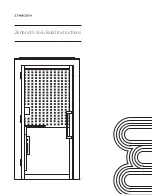
SEQUENCER WITH
DIFFERENTIAL PRESSURE
SWITCH
Technical notice
FI 72.0567.0221E
Page 42 / 45
Dust emission faults :
Depending on the configuration, a dust emission check can be performed.
Note: depending on the installation, one or more control inputs with several dust emission sensors are possible (see
electrical diagram).
The check consists of:
- to check that there is no appearance of dust emission downstream the filter when actioning a declogging
solenoid valve.
- to check that there is no appearance of dust emissions outside a cleaning cycle
The check is made from a “dust emission” logic input to which a dust emission control device is wired (example:
SPX50 sensor). The "dust emission" information is taken from this input.
The type of operation of the input can be specified (see parameters
→
Dust emission)
Note: The SPX50 sensor has the advantage of being able to quickly detect dust peaks on the one hand and
simultaneously monitor the average emission rejection against an alarm threshold on the other hand. These two
information are given to the SFX+V2 via a single relay (see instructions associated with the SPX50 dust emission
control device).
Check when actioning a declogging solenoid valve:
When actioning a SV, a T15 control time is initiated.
If during this time T15 a “dust emission” is detected, a “SV dust emission” fault is generated for this SV.
The control is effective only if the "dust emission" information is not present when the SV is activated.
If a SV concerning the same rejection probe is activated before the end of T15 (for example T15> T2), then we act
as if T15 had ended. A new control restarts on the last actioned SV.
The "SV dust emission" fault is auto-reset if a shot on the corresponding SV no longer generates a dust emission.
The SV dust emission fault is indicated by:
- « Dust emission fault : cell n°
xx
SV n°
yy
»
xx
being the number of the cell and
yy
the number of the SV of the cell that caused the fault (theoretical).
If a dust emission fault is present on a SV, then this SV is no longer actioned unless the total number of SV in dust
emission fault exceeds the set value. In this case all the SV are actioned, whether they are faulty or not (see
parameters
→
Dust emission).
Check outside a declogging cycle:
Outside a declogging cycle, if the "dust emission" information appears longer than the time T19, then a "general dust
emission" fault is generated.
T19 is initialized when the SFX+V2 controls the dust emission following the activation of a declogging SV.
The "general dust emission" fault is auto-reset if there is no longer the "dust emission" information.
The general dust emission fault is reported but has no influence on the declogging cycle.
The general dust emission fault is indicated by:
- « General dust emission fault sensor n°
xx
»
xx
being the dust probe number.




































